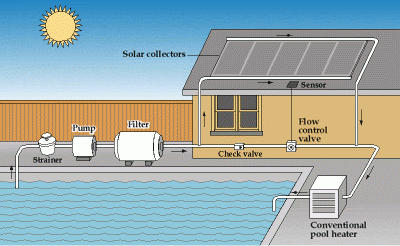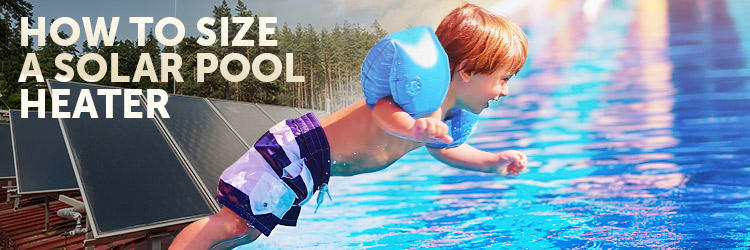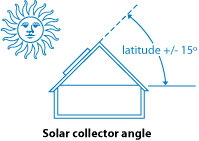Adding a solar pool heater must have crossed the minds of some of you at one point. Maybe you wanted to make an effort to go green, but most likely it was after seeing your pool heater’s first big gas bill. How it works, what’s it made of, and which is the best for your pool are things that remain a mystery to some pool owners. Well, never fear, we will give you the basics of solar pool heating.
What Is a Solar Heater?

The most common type of solar pool heater is an array of polypropylene (PP) veined mats that are spanned between two feed pipes. The mats, also called collectors, are laid out in direct sunlight to absorb its heat. As water is pumped through the mat’s veins, heat is transferred from the PP mat to the water. The water travels back to your pool to provide that cozy “chill-free” feeling in your pool.
A less common, but more expensive, type of solar heater is the glazed panel heater. These are aluminum-backed panels with copper piping sandwiched between tempered glass shields. Glazed solar panels are more efficient in transferring heat, but can be twice the price.
For above ground pool owners, there are less expensive lightweight options, like the Game Solar Pro, for heating your pool. These coiled packs of solar can be chained to heat rectangular pools that are up to 16’X32′ in size.
 How to Size a Solar Heater?
How to Size a Solar Heater?
To size a solar heater, you must first calculate the area of the pool’s surface. If you have a rectangular pool it is a simple length X width formula. However, for a Lagoon, or Kidney Shaped use online pool surface area formulas like the ones found here. In this example we will say our pool’s surface area is 500 square feet.
The solar heater panel array should equal 50-60 percent of your pool’s water surface area. In our example, we have a pool area of 500 square foot which means the required area of solar panels would be 250-300 square feet.
Whether a heater is gas or solar, do not be afraid to oversize it by going up to 70-80 percent of the pool area. The more panels there are to heat the water, the quicker your pool will get to your desired temperature.
Where Are You Going to Put It?
Before you buy a solar heater, make sure to scout the property for a reasonable place to install your panels. Be mindful of:
Solar panels require proper planning to ensure the array is in the best location to soak up the sun’s rays. The optimal position for solar panels is on a house’s roof facing true south. The panel tilt varies according to the time of year you are heating. If you are heating during the summer months only, tilt the panels 10-15 degrees. For year-round use, tilt them equal to your latitude (if you are in the northern hemisphere). At these angles an unobstructed rooftop should allow the panel all day heating time.
Unfortunately not everyone’s house has an unobstructed 8’ X 20’ roof section that faces true south. In those cases you will have to pick your position. Homeowners have laid out heater panels on the ground, decks, and have even hung them from a fence. Panels come with mounting kits so you can mount them to most structures that are sturdy enough to hold the panels plus the water they hold.
Solar Panels Are Not Just for Heating
Solar panels have a dual function, because they can be used to cool your pool as well. In the super hot climates of Arizona, New Mexico, and Texas, pool owners have little use for heating a pool in July. Instead, these crafty folk run their solar heaters at night when the temperature is significantly cooler. As the warm water flows through the cooler panel, it chills the water to a more agreeable temperature allowing for comfortable morning swims.
Solar Controllers

Solar controllers provide your panels with flow only during peak sunlight hours by using a combination of valve actuators, water, and air temperature sensors. These control systems are virtual must-haves to ensure your pool system is operating at its highest efficiency.
OK, so you have mounted the solar panels, and everything is running OK, but how do you make sure your solar panels are only used at optimal times of the day? Setting your pump schedule to run all day is a possibility, but it is not a cost-efficient one. Remember, the reason we installed solar panels was to save money and you lose that advantage if you’re running your pump around the clock. Also, if you run water through a cool solar heater, it will drop the temperature of your water, thus totally negating any gains.
Solar controllers, like the Goldline or Compool, monitor current water temperature, desired temperature, and sun exposure to gauge when the flow should be diverted to the solar panels. In addition, automation lowers the strain on your filter system.
The Downside to Solar Energy
Unfortunately, it is not all sunshine and lollipops when it comes to solar energy, there are drawbacks to utilizing the free energy of the sun
Slow Heat Gain
Solar heaters are not ideal for pool owners who want a quick heat option for their pools or hot tubs. Solar heaters are completely dependent on the sun for their heat, which means heating can be interrupted by clouds or even the time of day depending on the position of the sun. This makes solar heating a bad choice for situational heating, like hot tubs. Situational heating is when you need to crank your heater for a special occasion, requiring the heater to raise your water temperature several degrees in a short period.
Solar heaters are great for long-term water temperature management, but are not designed for the maintenance of high temperatures and are not capable of raising temperatures several degrees in a few minutes. Consider solar heaters as the tortoise, rather than the hare. We all know the tortoise wins, but the hare probably has more fun.
If you need heat, and you need it fast, use a gas heater for pools and spas, and if you have a spa only, an electric heater works nicely too.
The Look
Solar panels are not that pretty to look at, and will likely never be confused with a piece of art. So, having them on display for your neighbors may cause strife. Some pools and homes are restricted by space, meaning the installer may have to get creative when installing the panels. A homeowner may be forced to install the solar panel on the front slant of the roof facing the street or the side of the house. There are homeowner associations (ugh) that have rules (and bylaws) against the placement of panels within view from the street.















Leave a Reply